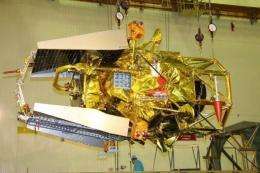The Phobos-Grunt probe at Russia's Baikonur cosmodrome, October 2011. The European Space Agency (ESA) has said it had been unable to establish a new link with Russia's stricken Mars probe but added that the craft's orbit seemed to have become more stable.
The European Space Agency (ESA) said on Friday it had been unable to establish a new link with Russia's stricken Mars probe but added that the craft's orbit seemed to have become more stable.
ESA's tracking station in Perth, Western Australia monitored the airwaves for eight hours from 2012 GMT on Thursday until 0404 GMT Friday but did not pick up any fresh signals from Phobos-Grunt, the agency said in a press release.
There were four brief slots, each lasting no more than eight minutes, when Phobos-Grunt was passing overhead and communication was theoretically possible, it said.
The next chance to listen will be on Monday.
On Tuesday, the Perth tracking station made the first contact with Phobos-Grunt since it got stuck in Earth orbit after launch on November 9.
On Thursday, the Russian space agency said it had received some telemetry data and engineers were working on the information, the Interfax news agency said.
"Our Russian colleagues provided a full set of telecommands for us to send up and Perth station was set to use the same techniques and configurations that worked earlier," said ESA's Wolfgang Hell, in charge of liaising with Russia over Phobos-Grunt.
"But we observed no downlink radio signal from the spacecraft."
Phobos-Grunt is Russia's first interplanetary mission since 1996, when an attempt to send an instrument-laden 6.1-tonne probe to the Red Planet, Mars 96, ended with a failure just after launch.
The five-billion-ruble ($165-million) scout is designed to travel to the Martian moon of Phobos, scoop up soil and return the sample to Earth by 2014.
But mission control lost radio contact with the 13.5-tonne craft hours after launch, leaving engineers baffled as to where it was.
ESA added, though, that observations from the ground indicated that Phobos-Grunt's orbit had become more stable, which was encouraging.
"This could mean that the spacecraft's attitude, or orientation, is also now stable, which could help in regaining contact because wed be able to predict where its two antennas are pointing," said Manfred Warhaut at ESA's European Space Operations Centre (ESOC) in Darmstadt, Germany.
(c) 2011 AFP























